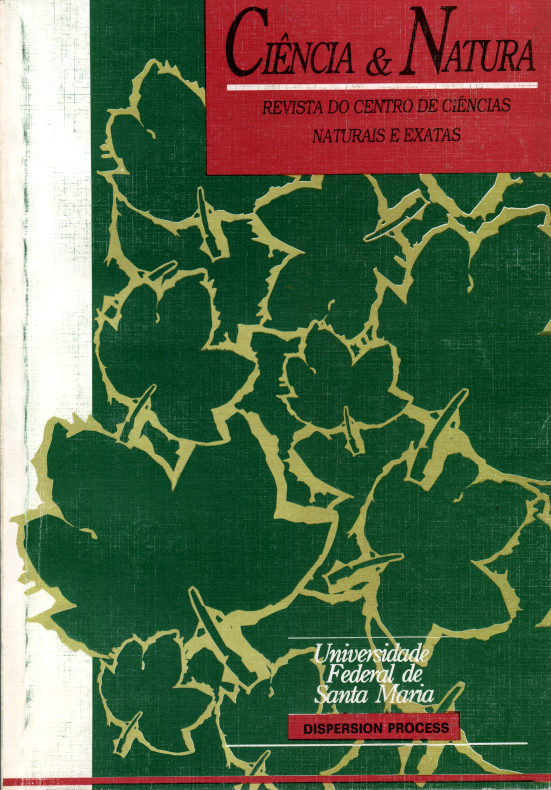Simple estimation of surface roughness parameters from single level sonic anemometer data
DOI:
https://doi.org/10.5902/2179460X36914Abstract
The estimation of joint values of both the roughness length z0 and the displacement height d is considered in the context of the MoninObukhov similarity law for the windspeed profile. When focused on single level data sets from one sonic anemometer (i.e. wind velocity, Reynolds stress and sensible heat flux data sets at one height), it is shown that this problem can be reduced to a simpler least squares procedure for one variable only. This procedure is carried out over a proper function of the data, representing the relative uncertainty of the roughness length, σz0/z0. This is minimized with respect to d, giving a direct estimate of d, z0, and their statistical uncertainty. The scheme is tested against a field-experiment data set.Downloads
References
Cassardo C., D. Sacchetti , M.G. Morselli, D. Anfossi, G. Brusasca and A. Longhetto, 1995: A study of the assessment of air temperature and sensible-heat and latent-heat fluxes from sonic anemometer observations. Il Nuovo Cimento C, 4, 419-440. DOI: https://doi.org/10.1007/BF02511367
Garratt J.R.,1992: The Atmospheric Boundary Layer. Cambridge University Press, 316 pp.
McMillen R.T.,1988: An eddy correlation tecnique with extended applicability to non-simple terrain. Bound.-Layer Meteor., 43, 231-245. DOI: https://doi.org/10.1007/BF00128405
Panofsky H.A.and J.A. Dutton, 1984: Atmospheric Turbulence. John Wiley & Sons, New York, 397 pp.
Sozzi R., M. Favaron, T.Georgiadis, 1998: Method for the estimation of surface roughness and similarity function of wind speed vertical profile. J. Appl. Meteor., 37, 461-469. DOI: https://doi.org/10.1175/1520-0450(1998)037<0461:MFEOSR>2.0.CO;2
Wieringa J.,1993: Representative roughness parameters for homogeneous terrain. Bound.-Layer Meteor. 63, 323-363. DOI: https://doi.org/10.1007/BF00705357
Downloads
Published
How to Cite
Issue
Section
License
To access the DECLARATION AND TRANSFER OF COPYRIGHT AUTHOR’S DECLARATION AND COPYRIGHT LICENSE click here.
Ethical Guidelines for Journal Publication
The Ciência e Natura journal is committed to ensuring ethics in publication and quality of articles.
Conformance to standards of ethical behavior is therefore expected of all parties involved: Authors, Editors, Reviewers, and the Publisher.
In particular,
Authors: Authors should present an objective discussion of the significance of research work as well as sufficient detail and references to permit others to replicate the experiments. Fraudulent or knowingly inaccurate statements constitute unethical behavior and are unacceptable. Review Articles should also be objective, comprehensive, and accurate accounts of the state of the art. The Authors should ensure that their work is entirely original works, and if the work and/or words of others have been used, this has been appropriately acknowledged. Plagiarism in all its forms constitutes unethical publishing behavior and is unacceptable. Submitting the same manuscript to more than one journal concurrently constitutes unethical publishing behavior and is unacceptable. Authors should not submit articles describing essentially the same research to more than one journal. The corresponding Author should ensure that there is a full consensus of all Co-authors in approving the final version of the paper and its submission for publication.
Editors: Editors should evaluate manuscripts exclusively on the basis of their academic merit. An Editor must not use unpublished information in the editor's own research without the express written consent of the Author. Editors should take reasonable responsive measures when ethical complaints have been presented concerning a submitted manuscript or published paper.
Reviewers: Any manuscripts received for review must be treated as confidential documents. Privileged information or ideas obtained through peer review must be kept confidential and not used for personal advantage. Reviewers should be conducted objectively, and observations should be formulated clearly with supporting arguments, so that Authors can use them for improving the paper. Any selected Reviewer who feels unqualified to review the research reported in a manuscript or knows that its prompt review will be impossible should notify the Editor and excuse himself from the review process. Reviewers should not consider manuscripts in which they have conflicts of interest resulting from competitive, collaborative, or other relationships or connections with any of the authors, companies, or institutions connected to the papers.






